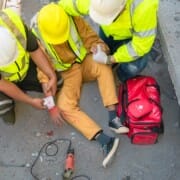June is National Safety Month
June 16-22

A Comprehensive Look at Workplace Safety
Workplace safety is an issue that’s at the forefront of many organizations’ concerns. According to Injury Facts, in 2022 alone, there were 4,695 deaths due to preventable workplace incidents. In addition to this alarming figure, there were also 791 deaths due to workplace homicide and suicide. On top of these fatalities, there were also 4.3 million reported cases of work-related injuries that required medical consultation.
In light of these disturbing statistics, the importance of maintaining a safe work environment cannot be overstated. Workplace safety is not just a concern for employees but also for employers. They are duty-bound to provide a safe workspace, which includes providing the necessary financial support and management oversight.
The Role of Employers
Employers have a significant role to play in ensuring workplace safety. This involves:
- Financial Support: Businesses must invest in safety equipment, including personal protective equipment (PPE), and other tools necessary to maintain a safe work environment.
- Management Oversight: Supervisors and managers must take an active role in overseeing workplace safety. This involves regular inspections to ensure compliance with safety standards, and taking swift action to address any potential hazards.
- Training: Employers must provide comprehensive safety training to their workers. This includes instruction on the proper use of PPE, tools, and equipment, as well as training on how to respond to emergencies.
The Role of Employees
Just as employers have a responsibility to provide a safe work environment, employees also have a role to play in maintaining workplace safety. This involves:
- Adhering to safety protocols and guidelines
- Using PPE and other safety equipment properly
- Reporting any potential hazards to supervisors
- Participating in safety training and drills
Workplace safety is a shared responsibility. By working together, employers and employees can help to reduce the risk of workplace injuries and fatalities.
Safety Management Systems
A key component in maintaining workplace safety is the implementation of a safety management system. This is a systematic approach to managing safety, including the necessary organizational structures, accountabilities, policies, and procedures. The objective of a safety management system is to continuously identify potential hazards and reduce risks to an acceptable level. Get a free demo of our safety management system.
As we recognize National Safety Month, it’s important to renew our commitment to safety, from the workplace to anyplace. This commitment isn’t just about making a pledge, but about taking concrete actions to ensure a safer work environment. By doing our part, we can contribute to a safer workplace, and ultimately, a safer world.
Safety Engagement: Promote First Aid from the Workplace Safety Experts
June is National Safety Month, and organizations across the United States are focusing on promoting safety in the workplace. One of the most critical aspects of workplace safety is the ability to administer first aid and CPR effectively, and Infinit-I training management system is at the forefront of offering this vital training.
First aid and CPR training in the workplace can literally mean the difference between life and death. Rapid, effective first aid can ensure that minor injuries don’t become major ones, and that major ones are stabilized while waiting for professional medical assistance. The importance of having trained first aid personnel cannot be overstated.
Infinit-I’s training program is recognized nationally and exceeds the OSHA First Aid Standard 29 CFR 1910.151, a critical measure in the industry. This ensures that workers are getting the most comprehensive training available, meeting and surpassing national standards.
The benefits of Infinit-I’s training program include:
- Adherence to the best practices outlined by OSHA
- Cost-effectiveness compared to in-person training providers
- Short microlearning videos supplemented with quizzes to ensure full comprehension
- Allowing employees to train at their own pace online
- The program is specially designed for the workplace
In addition to the standard first aid and CPR training, Infinit-I also offers specialized training tailored to meet the unique needs of your industry. This is especially important as different workplaces have different potential hazards and risks, which require specialized training to address.
As an employer during National Safety Month, it’s essential to be prepared for all types of potential injuries that could occur in your workplace. Providing training to staff not only provides peace of mind but also equips your employees with the skills they need to potentially save a life.
Infinit-I’s training is not just comprehensive and industry-leading, but it’s also convenient and affordable. Their online format allows for flexible learning, ensuring that your employees can learn at a pace that suits them, without the need for expensive and time-consuming in-person training sessions.
As we recognize National Safety Month, it’s crucial to prioritize workplace safety, and Infinit-I’s first aid and CPR training provides an excellent resource for employers. By investing in your employees’ skills and safety, you’re not just meeting regulatory standards – you’re creating a safer, healthier workplace for everyone.
Road Safety Measures
June marks the National Safety Month, and in light of this, it’s important to revisit the key factors that contribute to our safety on the road. Maintaining our safety and that of others is a responsibility that we shoulder every time we get behind the wheel. A deeper understanding of how to share the roads safely can significantly reduce the risk of accidents.
One of the common challenges drivers face are highway work zones. These areas can be a hazard due to several factors:
- Workers and construction activities may encroach into driving lanes.
- Hazards may be present even when no construction activity is underway; these can include large edge drop-offs, rough pavement, sharp turns, and misleading old pavement markings.
- Construction vehicles will enter and leave construction zones at low speeds and unexpected places.
In light of the National Safety Month, it’s important to remember that larger vehicles like trucks have blind spots that make it difficult for them to see smaller vehicles around them. To mitigate this, drivers should:
- Follow at a distance that allows them to see both of the truck’s outside mirrors.
- When passing a larger vehicle, they should not cut back in without first being able to see the front tires of the truck on the pavement in their inside rearview mirror.
- Stay behind larger vehicles signaling a right turn, away from the curbside, until the turn is completed.
School buses are another significant factor to consider. The presence of school buses means children are or may be nearby. When approaching a school bus, drivers should:
- Reduce their speed.
- Be prepared for children to appear suddenly.
- Stop if the bus’s red lights are flashing and the stop arm is extended.
Bicyclists and motorcyclists share the road with larger vehicles. They may be harder to see and can appear unexpectedly, leading to hazardous situations. To share the road safely with cyclists and motorcyclists, drivers should:
- Be considerate and patient, giving them their space and passing with care.
- Be aware and use the far hand reach when exiting a parked vehicle.
- Drive defensively by constantly scanning the roadway for hazards and using a safe following distance when behind a motorcycle.
As part of the National Safety Month, it’s crucial to remember that as drivers, we are responsible for our roadway community. Committing to drive safely and defensively reduces traffic collisions and violations, making the roads safer for everyone.
Identifying and Addressing Safety Hazards
June is National Safety Month, and in observance, it’s important to discuss the key points presented in this document about identifying and addressing safety hazards. Safety is a critical aspect of both our professional and personal lives, and understanding potential hazards can help prevent injury, illness, or even death.
- Understanding Hazards: Hazards can be defined as any existing or potential condition that can result in harm. These can take many forms, such as physical obstacles, chemical substances, biological threats, or ergonomic issues. Recognizing these hazards early on can allow them to be addressed and resolved, preventing potential harm.
- Role of Employees: Employees play a crucial role in maintaining safety. As they are most familiar with their job, their workstation, and their routines, they are uniquely positioned to identify anything out of the ordinary. It’s important that employees feel empowered to report these observations, even if they seem obvious or have likely been noticed by others.
- Types of Hazards: According to the Nine Elements of a Successful Safety & Health System, hazards can be categorized into four types:
- Chemical: Exposure to harmful substances
- Physical: Risks of injury from physical contact or environmental conditions
- Biological: Exposure to harmful biological agents
- Ergonomic: Risks associated with posture, repetitive work, or workstation design
- Control Measures: The document outlines three key methods to control hazards. This includes engineering hazards out or replacing them with a safer alternative; applying administrative controls, like policies to prevent exposure; and using personal protective equipment to create a barrier between the person and the hazard.
- Safety at Home: It’s important to remember that hazards aren’t limited to the workplace. They can also occur at home, and employing the same vigilance and preventive measures can help ensure the safety of your loved ones.
- Participation in Safety Processes: If an incident occurs, it’s crucial that employees participate in the incident investigation process. This can help identify the root causes of the incident and prevent future incidents from occurring.
- Continuous Learning: For further resources on this topic, consider checking out the visual literacy research from the Campbell Institute. This research offers a unique perspective on hazard identification and can enhance safety practices.
National Safety Month serves as a reminder of the importance of constant vigilance in identifying and addressing hazards. By working together, we can create a safer environment for everyone.
Preventing Workplace Falls
June is National Safety Month, and one key area of focus is preventing falls in the workplace. Such incidents are among the leading causes of preventable injuries, leading to time away from work. Simple tasks like walking can become hazardous if not performed with caution. Key dangers associated with walking include distraction, inappropriate footwear, poor walking surfaces, damaged surfaces, and basic housekeeping.
Distractions, especially from portable electronics like cell phones, can be hazardous. Reading texts or memos, engaging in intense conversations, rushing, and carrying too much in your hands can all lead to accidents. It’s crucial to remain vigilant and aware of changes in elevation, cracks, or holes in flooring, and other hazards.
Choosing the right footwear based on your work environment and weather conditions can also play a significant role in preventing falls. Footwear should be suitable for the environment, whether that’s steel-toed boots or comfortable shoes with a good grip. Planning ahead for changes in environment and weather is essential.
Furthermore, housekeeping can be an effective measure in preventing falls. Some tips include:
- Keep papers and boxes off the floor and out of walkways.
- Ensure drawers are kept closed to prevent collision.
- Keep cords properly covered and out of walkways.
- Ensure proper lighting – replace any burnt-out bulbs.
- Clean up spills immediately.
- Use a ladder or step stool instead of standing on a chair to reach for high objects.
Remember, walking is an integral part of the workday, whether it’s on the factory floor, outside during a break, or moving from one meeting to another. With foot traffic comes the potential for a fall. Therefore, during National Safety Month, and all year round, it’s important to stay vigilant and maintain safe practices in both the workplace and at home to prevent falls.
June is National Safety Month
Focus on promoting safety in various areas such as workplace, roadway, and hazard identification. Employers and employees share the responsibility of maintaining a safe work environment, which includes investing in safety equipment, providing comprehensive training, and adhering to safety protocols. Infinit-I offers comprehensive first aid and CPR training, exceeding OSHA standards. Road safety measures include being mindful of highway work zones, larger vehicles’ blind spots, and the presence of school buses, cyclists, and motorcyclists. Identifying and addressing safety hazards, both in professional and personal lives, is crucial. Lastly, preventing falls in the workplace can be achieved through vigilance, appropriate footwear, and good housekeeping practices.
FAQs
What is the purpose of National Safety Month?
National Safety Month is a time to focus on promoting safety in various areas such as the workplace, roadway, and hazard identification. It’s an opportunity for employers and employees to reinforce their commitment to maintaining a safe work environment.
Why is safety engagement important?
Safety engagement involves actively participating in safety practices. This includes understanding and following safety protocols, reporting potential hazards, and participating in safety training and drills. It helps create a culture of safety in the workplace.
How can a training management system improve workplace safety?
A training management system, like the one offered by Infinit-I, provides comprehensive and industry-leading safety training. This includes first aid and CPR training, which can literally mean the difference between life and death in an emergency.
What are the benefits of a training management system?
Benefits include adherence to best practices, cost-effectiveness compared to in-person training providers, short microlearning videos supplemented with quizzes to ensure full comprehension, allowing employees to train at their own pace online, and programs specially designed for the workplace.
What is Roadway Safety?
Roadway safety involves being mindful of potential hazards on the road, such as highway work zones, larger vehicles’ blind spots, and the presence of school buses, cyclists, and motorcyclists. It’s about being responsible for our community on the road and driving safely and defensively.
How can we reduce risk in the workplace?
Risk can be reduced by identifying and addressing hazards. This includes understanding hazards, reporting any observations, and implementing control measures like engineering hazards out, applying administrative controls, and using personal protective equipment.
What can be done to prevent slips, trips, and falls in the workplace?
Preventing falls involves being vigilant and maintaining safe practices like avoiding distractions, wearing appropriate footwear, and maintaining good housekeeping practices. This includes keeping walkways clear, ensuring proper lighting, and cleaning up spills immediately.
Why is it important to identify and address safety hazards?
Identifying and addressing safety hazards is crucial to preventing injury, illness, or even death. It involves understanding potential hazards and implementing measures to control them.
How can a safety management system improve ROI?
A safety management system can improve ROI by reducing the risk of workplace injuries and fatalities. This can save on costs associated with accidents, such as medical expenses and compensation. Moreover, a safe workplace can lead to improved employee morale and productivity.
What role do employers play in ensuring workplace safety?
Employers are responsible for providing a safe work environment. This involves investing in safety equipment, providing comprehensive safety training, and overseeing workplace safety, including regular inspections and swift action to address potential hazards.
What role do employees play in maintaining workplace safety?
Employees are responsible for adhering to safety protocols and guidelines, using safety equipment properly, reporting any potential hazards to supervisors, and participating in safety training and drills.
Why is safety a shared responsibility?
Safety is a shared responsibility because both employers and employees play a role in maintaining a safe work environment. By working together, they can help to reduce the risk of workplace injuries and fatalities.
What does a safety management system entail?
A safety management system is a systematic approach to managing safety, including organizational structures, accountabilities, policies, and procedures. Its objective is to continuously identify potential hazards and reduce risks to an acceptable level.
What is the role of safety training in preventing workplace hazards?
Safety training plays a significant role in preventing workplace hazards. It equips employees with the knowledge and skills they need to identify potential hazards and respond appropriately.
How can training at a company’s own pace help improve safety?
Allowing employees to train at their own pace ensures they fully understand and absorb the safety protocols and practices. This increases the chances that they will apply the training effectively in real-world situations.
What is the significance of having trained first aid personnel in the workplace?
Having trained first aid personnel in the workplace can ensure that minor injuries don’t become major ones, and that major ones are stabilized while waiting for professional medical assistance. This can be vital in preventing serious consequences from injuries at work.













